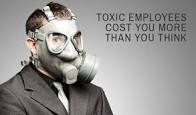Blogs
A Guide to Handling Toxic Employees
Navigating environmental hazards has always been relatively easy. A sign is generally erected letting people know what to expect ahead, be it a chemical spill, gas leak, or anything that could cause them any kind of harm upon exposure. All we have to do is find some detour around it, which is usually mapped out for us. More often than not, we are allowed, even urged by society to avoid these situations.
But sometimes, a wide berth is impossible to maintain. Sometimes, what we must contend with isn’t a spot marked on a map, or by any sign. We speak, of course, of that mobile hazard bubbling over with negativity, vitriol, and standoffishness: the toxic employee, or coworker. You know who they are. The air in the room becomes staler when they enter it. People are on edge. Moods shift. Food loses its taste. A chance interaction with this individual can dash that great morning you were having.
How do you navigate your work day, day in and day out, while in such close proximity to these people? How do you handle the seemingly endless barrage of sarcasm, selfishness, and cynicism? In this post, we will discuss some ways to contend with such toxicity, and prevent it from turning your medical practice into a bonafide fallout zone.
Putting your foot down
…which can mean either you, or your office manager having to confront the problem, head on. Now, it can be possible that this particular employee is very good at their job. In fact, they may seem indispensable, a crack medical coder, or a heavy hitter like a PA, or Nurse Practitioner. Nevertheless, as the head of your practice, you are also the head of “cleanup operations.” You must act early, before conditions become intolerable for other staff, or even patients. So dust off those thick, rubber boots.
Remember write-ups? Those citations you are obligated to dole out when a subordinate consistently underperforms, or behaves in an inappropriate and unprofessional manner? If your last experience with them occurred while on the receiving end in middle-school, you aren’t alone among independent physicians. If you aren’t sure how to do it, or even what a real write-up should look and sound like, there are templates available online, and even books dedicated to the subject. Got it? Good.
The key is to be thorough, and precise. Document each time a toxic employee performs poorly, or behaves in an inappropriate way toward you, your other staff, or patients. Make sure your practice has a policy in place for what happens after collecting multiple write-ups. Suspension? Maybe. Firing? Possible. Yes, this initial encounter will be difficult, and you may be tempted into an argument with this person. Firmness is key, but a reactionary response—frustration, threats, blame, and the like—will only add to an already bad mix.
It may hurt to lose this particular person, for any length of time. As we’ve covered in other posts, the hiring process is long, and difficult. But there are other things at stake here that are bigger than one worker, no matter how good they are at what they do: your reputation, and the respect of the rest of your office. In a previous post, we covered what inconsistency and lack of follow-through in the context of rewards and punishment can do to the morale at a practice. Don’t let it happen.
Working with, not against
Now for something a bit more optimistic. At this point, an idealistic physician, or office manager might be thinking, “Wait. Shouldn’t this come first? Why place such preliminary emphasis on the hardline approach?”
The simple answer is that they aren’t two separate approaches, rather two important phases of a dual-pronged solution. After establishing your authority and agency as the head of your practice, it’s time to execute some of what in a previous post we coined “emotional intelligence.” This means fostering your senses of compassion, humility, and empathy to assure this person that, while they must change, you are invested in that change. You want them to succeed, to be a better worker, and peer.
Be accessible. Slot some time to advise this employee. If circumstances favor it, try to coax the cause of their performance or behavior out of them, rather than coerce it. Maybe the things fueling their conflicts are universal: lack of training, professional burnout, depression, anxiety, divorce or death in the family, or even some level of substance abuse.
These meetings should be done in private, and preferably not in the HR office, the last usual stop before an employee cleans out their desk. In a neutral environment, you can now begin to discuss with this person what needs to change, and how they can go about it. Blame and criticism, no matter how appealing they may be to you, cannot have a place at this meeting. You may have suggestions of your own, but remember to get this person to contribute their own solutions for how they can improve.
The last part here operates a bit on faith. You now have to give them the opportunity to improve, to make good on the set of solutions you both brainstormed. To test their own emotional IQ in the same situations in which they previously lacked, or ignored it. Of course, if improvement isn’t consistent, or noted at all, then measures described in step one must be carried out. You gave them a fair chance to clean up their own act. The hard truth is that you cannot be responsible with cleaning up after them each day.
Brian Torchin
| HCRC Staffing | Brian@hcrcstaffing.com | www.hcrcstaffing.com
– See more at: http://3.228.224.47/blog/#sthash.regjTzUx.dpuf

